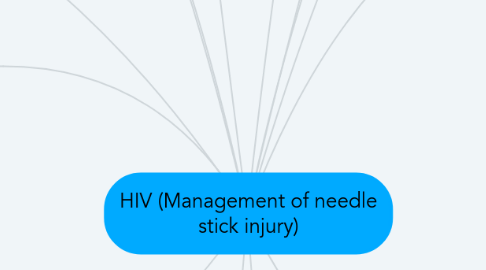
1. Replication
1.1. HIV virus enters cells by binding to CCR5/CXCR4 receptors on CD4 cells
1.2. RNA is converted to DNA by Reverse transcriptase enzyme
1.3. DNA integrates into host cell genome (integrase)
1.4. Viral DNA is transcribed to RNA by host cell
1.5. New virus particles bud form cell and maturation with aid of protease enzyme
2. Classification
2.1. Family: Retroviridae
2.2. Genus: Lentivirus
3. Pathogenesis
3.1. Virus binds to cells that have a CD4 receptor: T helper cells, monocytes, macrophages, T-cell precursors, dendritic cells and microglial cells
3.2. Cell death results in immunosuppression.
4. Lab tests
4.1. Serological assays
4.1.1. Rapid HIV strips
4.1.1.1. Routinely used. Most detect antibodies only. Gives immediate on-site result. With slightly lower sensitivity and specificity. Confirmed with 4th gen ELISA test.
4.1.2. HIV ELISA
4.1.2.1. 3rd generation: Detects HIV antibodies only
4.1.2.2. 4th generation: Simultaneously detects HIV antibodies and p24 antigen
4.1.3. P24 antigen
4.1.3.1. Indicates HIV infection. Not generally used - rather use combined test.
4.1.4. Western Blot
4.1.4.1. Confirmatory (follow-up) test. Not generally used.
4.2. Molecular assays
4.2.1. HIV PCR
4.2.1.1. Viral load testing not recommended in the setting of PEP
4.3. Diagnostic Markers
4.3.1. The following markers can be used (with dates after exposure):
4.3.2. Plasma RNA ~ 11 days
4.3.3. HIV - DNA PCR ~ 16 days
4.3.4. p24 antigen ~ 16 days
4.3.5. p24 antigen and anitbodies ~ 18 days
4.3.6. Antibodies ~ 21 days
5. Risk of infection
5.1. 0.3% for HIV
5.2. 30% for Hepatitis B virus
5.3. 3% for Hepatitis C virus
5.4. Increased risk if:
5.4.1. Source has advanced AIDS
5.4.2. Source has high viral load
5.5. Other factors:
5.5.1. Size of needle
5.5.2. Extent of injury
5.5.3. What tissue/fluids the needle was exposed to.
6. Structure
6.1. Enveloped, + sense single stranded RNA virus
6.2. Surface glycoproteins: GP 120 - binds to the CD4 receptors (CCR5 and CXCR4)
6.3. p24 core protein
7. Enzymes
7.1. Protease
7.2. Integrase
7.3. Reverse transcriptase
7.3.1. High mutation and recombination rate
8. The student requires PEP to decrease the risk of HIV infection. This 3 drug-combo again has a tenofovir backbone. Commonly used is Truvada (1 daily tablet TDF + FTC) and Isentress (1 tablet twice daily Raltegravir). PEP for Hep B virus is a combination of vaccine and immunoglobulin. No PEP is available for Hep C Virus.
9. Window and Incubation Period
9.1. The window period is defined as the time between potential exposure to the HIV infection and the point where the test for HIV will give an accurate result. This window period for a 4th generation antigen or antibody test is 4 weeks.
9.2. The incubation period is the time between infection with the virus and the onset of symptoms of AIDS. An infected person can still spread the virus during this period. Time ranges from a few months to ten years or more.
10. Treatment
10.1. Source
10.1.1. The source, if HIV positive, needs to receive first line HAART treatment. This is a fixed dose combination containing two NRTI's and one NNRTI. The combination of choice is: tenofovir, emtricitabine (or lamuvidine) and efavirenz (TDF + FTC/3TC + EFV) . This combo is also effective in treating Hep B virus infection.
10.2. Injured
11. Co-infections
11.1. TB, Toxoplasmosis, Hepatitis B and C, Kaposi sarcoma, Chancroid, Lyme disease, Cryptococcal meningitis, PJP, Oesophageal candiasis, HSV 1 & 2
12. Transmission
12.1. Sex
12.1.1. Oral sex with an infected person
12.1.2. Anal/vaginal sex without using a condom
12.2. Contact with fluids on mucosa/open skin: blood, semen, vaginal secretions, peritoneal or pleural fluid, breast milk, amniotic fluid
12.3. Vertical transimission
12.4. Sharing needles
12.5. Human bites if person is infected
12.6. Blood transfusion, blood product or organ infected with HIV
13. Precautions
13.1. Precautions to needle stick injuries
13.1.1. Wear gloves and a gown
13.1.2. Retractable needles
13.1.3. Wear eye protection (goggles)
13.1.4. Don’t stick needles into patient’s mattress
13.1.5. Don’t let sharps bin overflow
13.1.6. Handle sharps safely
13.1.7. Don’t recap needle (with one hand or both)
13.1.8. Take extra care with handling needles when tired
13.1.9. Dispose needles safely in sharps bin
13.2. Precautions to splashes
13.2.1. Close any open wounds with plasters
13.2.2. Wash off blood immediately with soap and water

